Unitech Electronics PA500 Portable Data Collection Terminal User Manual
Unitech Electronics Co., Ltd. Portable Data Collection Terminal
Manual

Portable Data Collection Terminal
User Guide
Notice
This unit is equipped with a battery pack and backup battery. It is possible that the
Unitech PA500 may not power-on due to battery discharge as a result of storage.
In the above situation, plug the PA500 to the USB charging cable which is with DC in
port or put the unit into the cradle or docking station (with 5V/3A AC-DC adapter),
and recharge the unit for 16 hours in order to fully charge its backup battery.
The backup battery will charge from external power or the main battery (if the main
battery still has enough power to turn on). In the event the main battery is fully
charged, refrain from using the PA500 for 16 hours in order for the main battery to
fully charge the backup battery.
Backing-up data by backup battery only without the main battery installed in battery
compartment may take as long as 1 hour. Therefore, in order to prevent data
protection failure due to backup battery failure, do not leave the PA500 without the
rechargeable battery pack installed, or without connection to AC power for an
extended period of time.
Battery charge notice
It is important to consider the environment temperature whenever you are charging
the Lithium-Ion battery pack. The process is most efficient at normal room
temperature or slightly cooler. It is essential that you charge batteries within the
stated range of 0°C to 50°C. Charging batteries outside of the specified range could
damage the batteries and shorten their charging life cycle.
Storage and safety notice
Although charged Lithium-Ion batteries may be left unused for several months, their
capacity may be depleted due to build up of internal resistance. If this happens they
will require recharging prior to use. Lithium-Ion batteries may be stored at
temperatures between -20°C to 60°C, however they may be depleted more rapidly at
the high end of this range. It is recommended to store batteries within normal room
temperature ranges.
Federal Communication Commission Interference
Statement
This equipment has been tested and found to comply with the
limits for a Class B digital device, pursuant to Part 15 of the FCC
Rules. These limits are designed to provide reasonable
protection against harmful interference in a residential installation.
This equipment generates, uses and can radiate radio frequency
energy and, if not installed and used in accordance with the
instructions, may cause harmful interference to radio
communications. However, there is no guarantee that
interference will not occur in a particular installation. If this
equipment does cause harmful interference to radio or television
reception, which can be determined by turning the equipment off
and on, the user is encouraged to try to correct the interference
by one of the following measures:
- Reorient or relocate the receiving antenna.
- Increase the separation between the equipment and receiver.
- Connect the equipment into an outlet on a circuit different from
that to which the receiver is connected.
- Consult the dealer or an experienced radio/TV technician for
help.
This device complies with Part 15 of the FCC Rules. Operation is
subject to the following three conditions:
(1) This device may not cause harmful interference, and
(2) This device must accept any interference received, including
interference that may cause undesired operation.
(3) This device shall automatically discontinue transmission in
case of either absence of information to transmit or operation
failure.
INFORMATION TO USER
To assure continued compliance, any changes or modifications
not expressly approved by the party responsible for compliance
could void the user’s authority to operate this equipment.
IMPORTANT NOTE:
This equipment complies with FCC radiation exposure limits
set forth for an uncontrolled environment.
End users must follow the specific operation instruction for
satisfying RF exposure compliance.
This transmitter must not be co-located or operating in
conjunction with any other antenna or transmitter.
The maximum reported Body SAR Measurement (1g) value
is:
802.11b (2450MHz): 0.872 W/g
802.11g (2450MHz): 0.402 W/g
Contents
Chapter 1 Introduction 1
PA500 & Accessories 2
PA500 Features 3
Powerful System 3
Display 3
Barcode Scanner 3
Audio 3
Wireless Connectivity 3
Battery Life 3
User-friendly Interface 3
PA500 Tour 4
Front View 4
Rear View 6
Left and Right View 7
Top and Bottom View 8
First Steps with PA500 9
Chapter 2 Hardware and Command Interface 15
Using the Stylus 15
Using the SDIO/MMC Slot 16
Using the Laser Scanner 17
Using the Software Keyboard Button 19
Command Interface 20
Today Screen 20
Status Icons 23
Navigation Bar 24
Command Bar 24
Pop-up Menus 25
Notifications 26
Chapter 3 Getting Connected 29
Establishing Device-PC Connection 29
Installing Microsoft ActiveSync 29
Connecting the Device to Your Computer 30
Synchronizing with Your Computer 32
Connection Options 32
Synchronizing Information 42
Using ActiveSync to Exchange Files 44
Sharing Information 45
Connecting to the Internet 53
Chapter 4 Managing Programs 55
Accessing Programs 55
Opening a Program 55
Switching Between Programs 55
Accessory Programs 56
Scan2Key 56
Scanner Settings 57
Chapter 5 Customizing PA500 61
Adjusting Settings 61
Checking Main and Backup Battery Status 62
How to Save Battery Life 63
Changing the Automatic Power Settings 63
Adjusting Backlight Setting 64
Resetting the Device 67
Warm Boot 67
Clean Boot 68
Cold Boot 68
Viewing Flash ROM Files 69
Adding Programs 70
Adding Programs to Your Device 70
Adding a Program to the Start Menu 71
Removing Programs 75
Chapter 6 Regulatory and Safety Notices 77
System Specifications 77
CPU/Memory 77
Input/Output 77
Power 79
Barcode/Symbology 80
OS and Software Programming Tools 80
Mechanical and Environmental 80
Regulatory Compliance Statements 81
FCC Statement 81
Canadian Compliance Statement 81
European Conformity Statement 81
Laser Information 81
Index 83
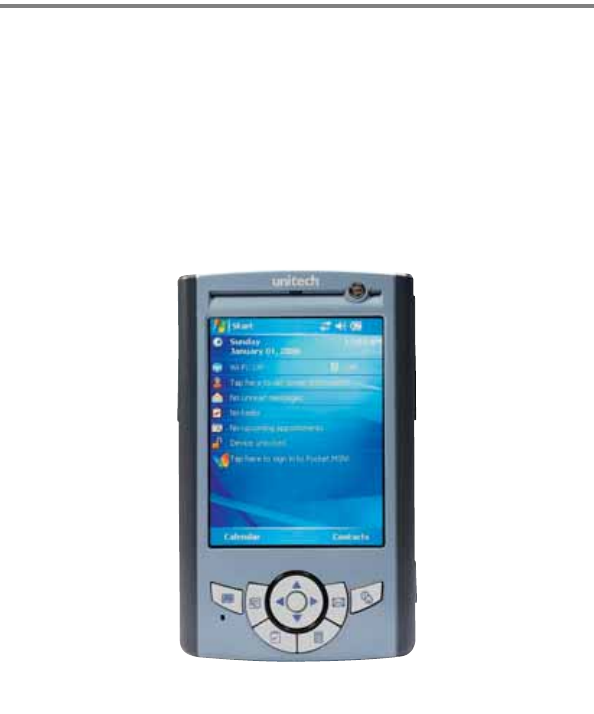
1
Chapter 1 Introduction
Thank you for purchasing PA500.
Your PA500 is a rugged, compact and lightweight palm-size computer. It
utilizes the Windows Mobile 5.0 operating system, and incorporates an
integral barcode scanning laser device, color LCD with touch screen,
keypad, IrDA interface, Bluetooth, and wireless communication capability. It
provides the user with a standard Windows-based environment for
customizing and operating the device.
This PA500 product reference guide will guide you to access your PA500.
Unitech PA500
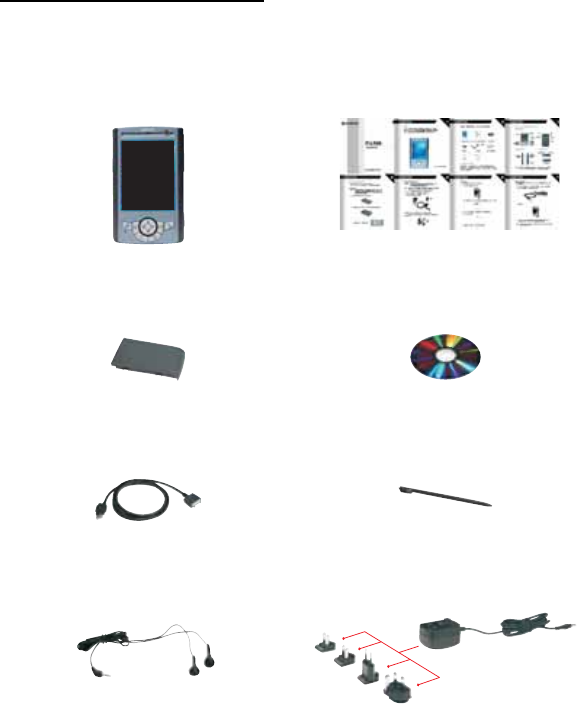
Chapter 1 Introduction2
PA500 & Accessories
After opening the box, please make sure the following accessories for the
PA500 are present:
* The adapter’s replaceable plug clips availability depends on region.
PA500 Main Body Unitech PA500 Quick
Reference Guide
Battery pack PA500 CD
USB charging cable Stylus
Earphone
AC adapter*

3
PA500 Features
Powerful System
• Microsoft Windows Mobile 5.0 operating system
• Intel PXA270 processor with speed of up to 520 MHz
• System memory:
• 64 MB SDRAM
• 64 MB Flash ROM
Display
• 3.5” QVGA LCD touch-sensitive screen
• 320 x 240 resolution
Barcode Scanner
• Symbol SE950
• Integrated Hitachi HD6433657W barcode decoder
Audio
• Supports Windows Media Player
• Voice recording and playback
Wireless Connectivity
• 802.11b + g with diversity antenna
• Bluetooth wireless technology
• Serial infrared port
Battery Life
• Normal usage: 6 hours
• Charging time: 3.5 hours
• Embedded backup battery cell
User-friendly Interface
• Quick launch hot keys for enabling software keyboard and other device
management tasks
• Trigger keys for barcode scanning
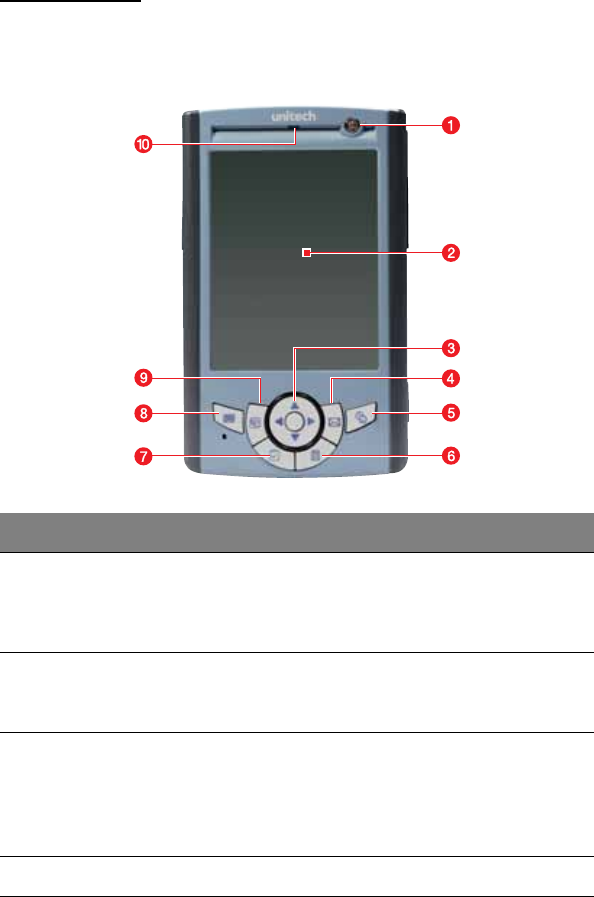
Chapter 1 Introduction4
PA500 Tour
The following section gives you a tour of the PA500 hardware interface.
Front View
No. Component Description
1 Power button If the device is off, press this button to turn it on.
Alternatively, when the unit is on, this key must be
pressed and held down for about two seconds in
order to turn the device off.
2 LCD Touch screen Displays the applications and data stored on your
device. It is touch-sensitive and responds to the
stylus or finger.
3 Navigation key Press the Action button, center of the navigation
key, to access the menu options and confirm your
selection.
Use the up, down, left, and right arrow keys to
navigate through the menu options.
4 Email button Launch Microsoft Outlook Express.

5
5 Today button Customize the look and information that is
displayed on the Today screen.
6 Calendar button Press to bring up Calendar. Calendar enables you
to conveniently manage your schedules and
appointments or any other activities associated
with a date and time.
7 Tasks button Keep track of what you have to do and prioritize
them based on their importance and urgency.
8 Software keyboard
button
Press to launch the Windows CE keyboard.
9 Notes button Press to open Notes. Notes allows you to quickly
capture thoughts, reminders, ideas, drawings, and
phone numbers. You can create a written note or
include a recording in a note.
10 Status indicator Indicates the battery charging and barcode
scanning status.
• Green - Battery is fully charged, the device is
running on battery power, or barcode scanning
process is completed without error.
• Red - Battery is charging, barcode scanner is
activated and processing.
No. Component Description
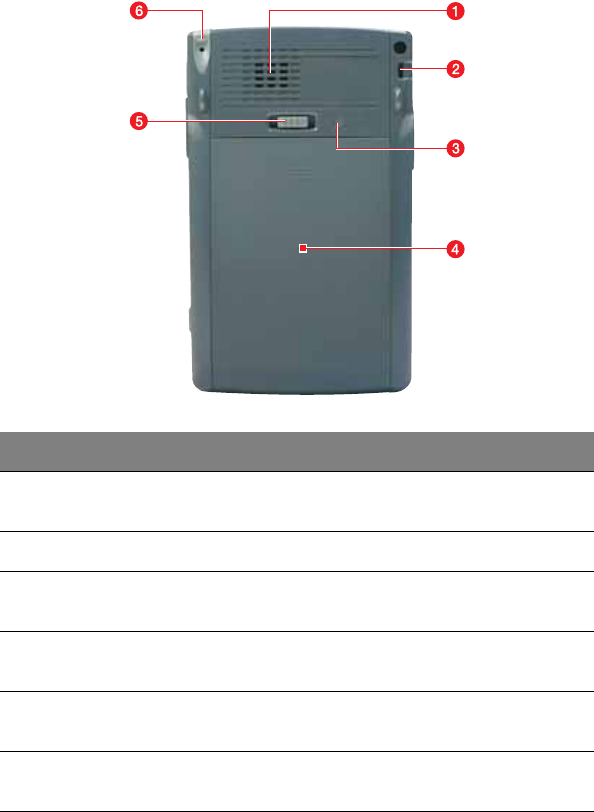
Chapter 1 Introduction6
Rear View
No. Component Description
1 Speaker Listen to audio media. When speaker phone is
active, sounds are emitted here.
2 Strap holder Eyelet for holding strap.
3 Reset button Press the end of the stylus into the button to reset
your device.
4 Main battery Removable and rechargeable 3.7 V, 2200 mAh
battery pack.
5 Battery release
latch
Slide toward the right side of the device and hold
firmly, then detach the battery from its bay.
6 Stylus holder To use the stylus, remove it from its holder and
hold it the same way you hold a pen or pencil.
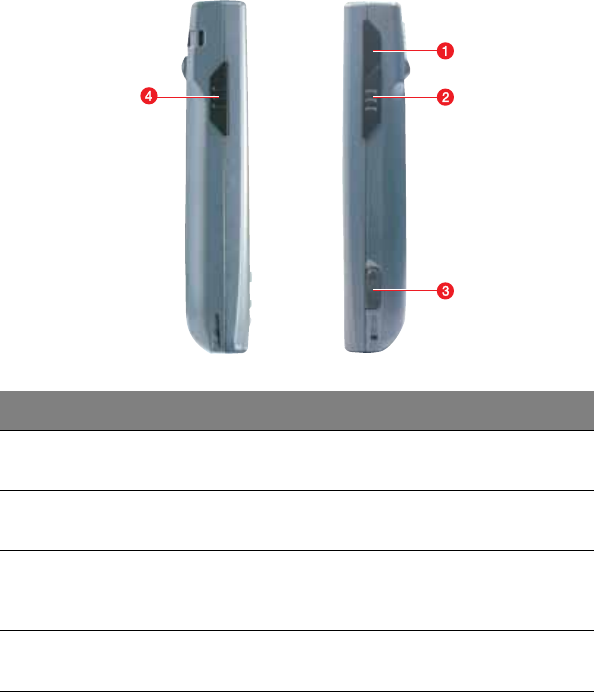
7
Left and Right View
No. Component Description
1 Infrared (IR) port Uses infrared technology to transmit and receive
data from other IR-enabled devices.
2 Right side scanner
trigger button
Press to activate the barcode laser scanner.
3 Earphone jack Lift the rubber cover from the earphone jack and
connect an audio line-out device (earphone or
headphone).
4 Left side scanner
trigger button
Press to activate the barcode laser scanner.
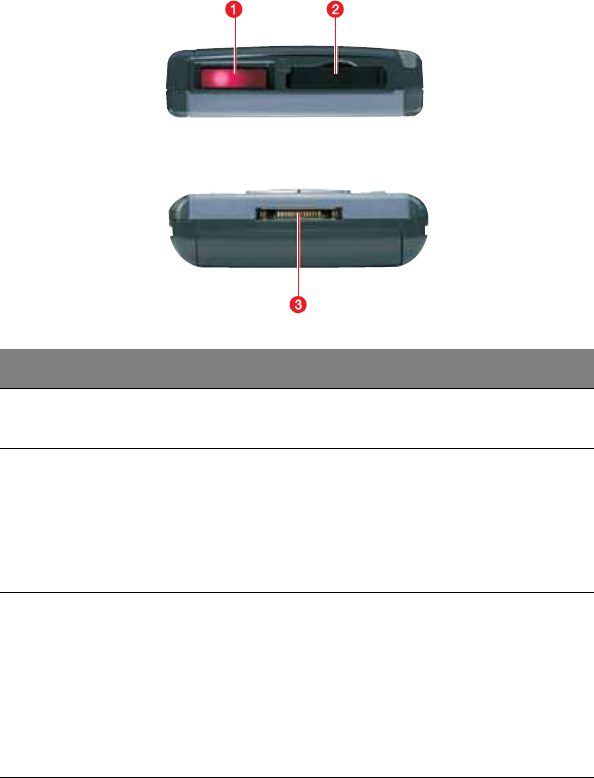
Chapter 1 Introduction8
Top and Bottom View
No. Component Description
1 Barcode laser
scanner (optional)
Reads and captures information on a barcode
label.
2 SDIO/MMC slot Accepts an SD (Secure Digital), MMC (Multimedia
Card) or SDIO (Secure Digital Input Output) cards,
allowing you to add more memory.
Install add-on applications or use audio text files
stored in it for use with internal applications. You
can also use it to back up data from your device.
3 Universal
connector
Connects your device to a USB charging cable,
which in turn connects to the computer’s USB port
and through the AC adapter to an electrical outlet.
This allows you to recharge your device and
perform an ActiveSync operation.
You can also use it to connect a peripheral
hardware, such as an docking station, to your
device.
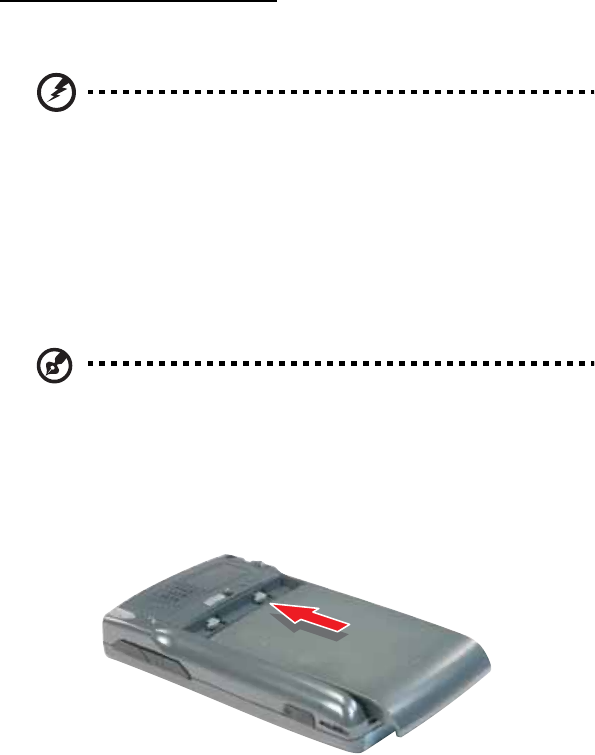
9
First Steps with PA500
Perform the following easy installation steps to start using your device:
1 Install the battery pack
WARNING! There is a risk of fire and burns if the battery pack is
handled improperly. DO NOT disassemble, crush, puncture,
short external contacts, or dispose the battery pack in fire or
water. DO NOT attempt to open or service the battery pack.
Dispose of used batteries according to local recycling guidelines
in your area.
A backup battery cell is embedded into your device to prevent data
loss in instances when the removable battery pack is removed or
completely discharged. This backup battery cell will support the
system for a maximum of 60 minutes only.
NOTE: To enable the internal battery cell to provide backup power
supply, charge your device with the main battery pack, for at least 3.5
hours.
(a) Position the battery pack, making sure the battery pack fits the
shape of the battery compartment.
(b) Slide the battery pack into the battery bay until it clicks into place.
2 Charge your device
For initial use, you need to charge your device for about 16 hours. After
that, you can charge it everyday to recharge the battery to full capacity.
You can charge your device using the USB charging cable or the
docking station.
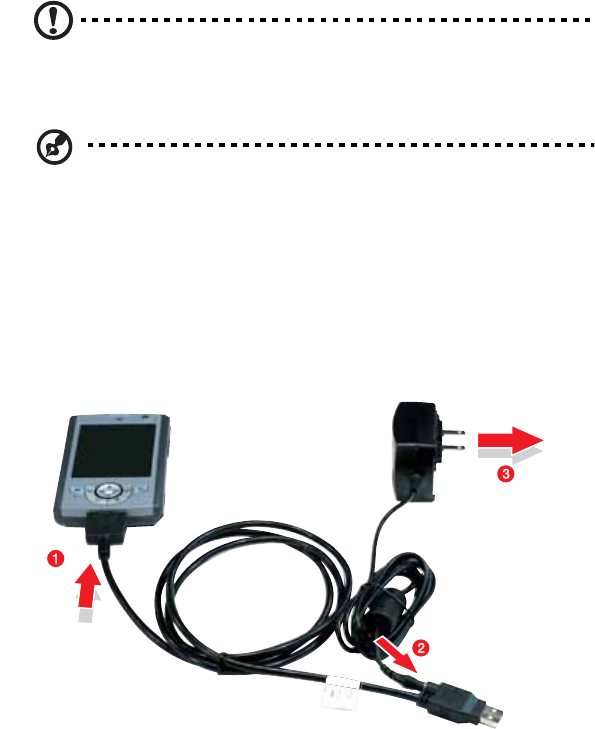
Chapter 1 Introduction10
CAUTION: Operating the PA500 for the first time without the AC
adapter, and without fully charging the backup battery may result in
loss of data stored in RAM memory.
NOTE: Data you enter may not be properly stored until the built-in
backup battery has been adequately charged.
To charge the device using the USB charging cable:
(1) Press and hold the connector button on the USB charging cable
and connect it to the PA500.
(2) Plug the AC adapter cable into the power jack on the USB
charging cable.
(3) Connect the AC adapter into an electrical outlet.
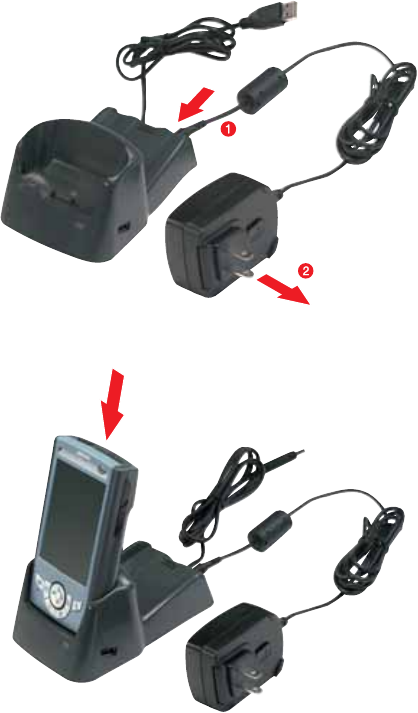
11
To charge the device using the docking station:
(1) Plug the AC adapter cable into the power jack on the docking
station.
(2) Connect the AC adapter into an electrical outlet.
(3) Slide the device into the docking station until it clicks into place.
The connection is secure when the bottom edge of the device is
aligned smoothly with the docking station, and the LED indicator
on the device lights up red.
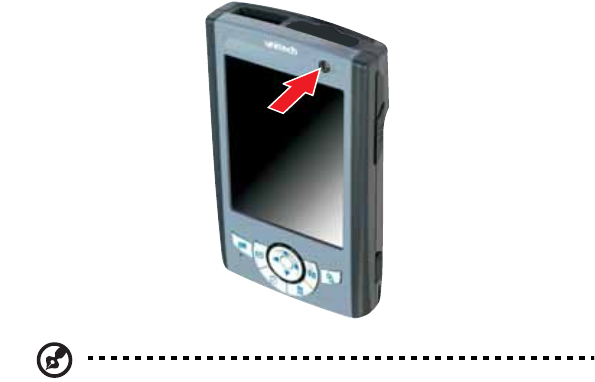
Chapter 1 Introduction12
LED status during charging:
• Solid red: Charging
• Solid green: Charging complete
If the battery level becomes low in the course of normal use, a
status icon appears on the device screen indicating low or very
low battery status. In both cases, perform an ActiveSync
operation to back up your data, then recharge your device as soon
as possible.
If the battery level reaches low status, the device will enter sleep
mode; if the battery level reaches very low status, the device will
enter deep sleep mode. In this case, you have about 72 hours to
recharge your device afterwhich you risk losing all data on your
device’s internal memory.
3 Start up the PA500
After you have initially charged your device for about 16 hours, the
device is ready to be used. You can now start up your device where
you’ll calibrate the display, set up the system time zone, and learn
some basic stylus usage.
(1) Turn on your device by pressing the power button on the front
panel.
NOTE: The PA500 screen ships with a protective plastic film. You may
remove this if desired by peeling from one corner. The screen will be
more susceptible to scratching without the film, but will be more
readable.
13
The Unitech PA500 welcome screen appears. The Windows
Mobile screen will appear shortly thereafter.
(2) Calibrate the PA500
The calibrate screen will automatically appear when the unit is
powered-on for the first time or after the system is reset. This
screen can also be accessed at any time by tapping Start >
Settings > System tab > Screen.
The PA500 will prompt you to calibrate the unit by tapping a
sequence of screen locations. Tap gently but firmly. When you
have completed the series of taps, press the Action button to
confirm it.
(3) Set the Time Zone, Date, and Time
Select your current time zone from the Time zone drop-down
menu, then tap Next.
(4) Follow all onscreen instructions to complete the set up. The setup
wizard provides tips for using the pop-up menus and assign a lock
password to access your device.
Wait for a few moments while the preloaded applications are
being installed into your device.
Chapter 1 Introduction14
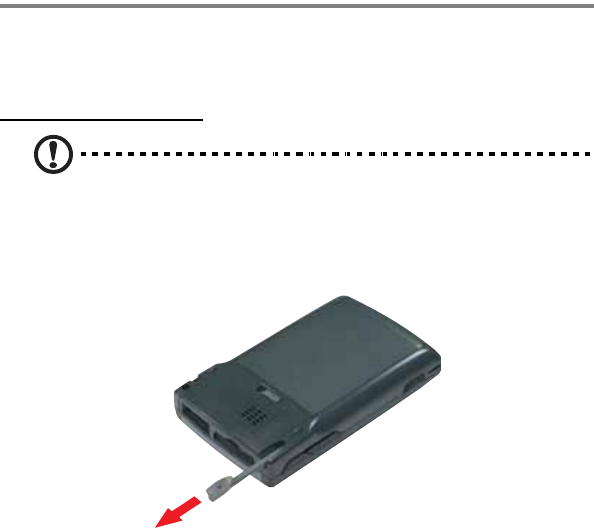
15
Chapter 2 Hardware and Command Interface
This chapter describes basic hardware procedures in using your PA500.
Information on the device’s command interface is also discussed.
Using the Stylus
CAUTION: Never use anything other than the PA500 stylus on the
screen. Using another object as a stylus could cause permanent
damage.
1 Remove the stylus from its holder.
2 Hold the stylus as you would a pencil.
3 To make a choice from a menu, lightly tap the tip of the stylus on that
choice.
4 To write data into a field on a form, use the stylus to print the letters or
numbers. Use very light pressure.
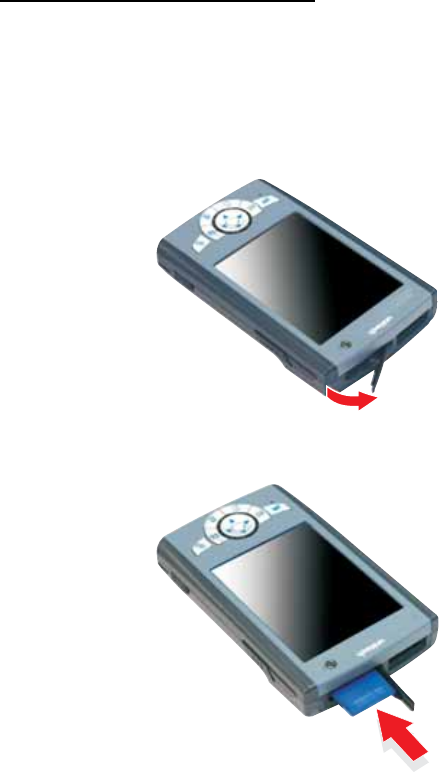
Chapter 2 Hardware and Command Interface16
Using the SDIO/MMC Slot
Your device has an expansion slot compatible with a range of SD, SDIO,
and MMC storage cards, which are primarily used to back up or transfer
files and data.
To insert a storage card:
1 Hold the device securely, then lift the rubber cover from the SDIO/
MMC slot.
2 Push the card into the slot until you hear an audible system sound; this
will signal that the card is already properly seated within the slot.
The card is secure when it is not protruding from the slot.
To remove a storage card:
1 Hold the device securely; then push against the top of the card, as if
you were pushing it further into the slot, letting the card spring out. An
audible system sound will signal that the card has been released.
2 Gently remove the card from the slot.
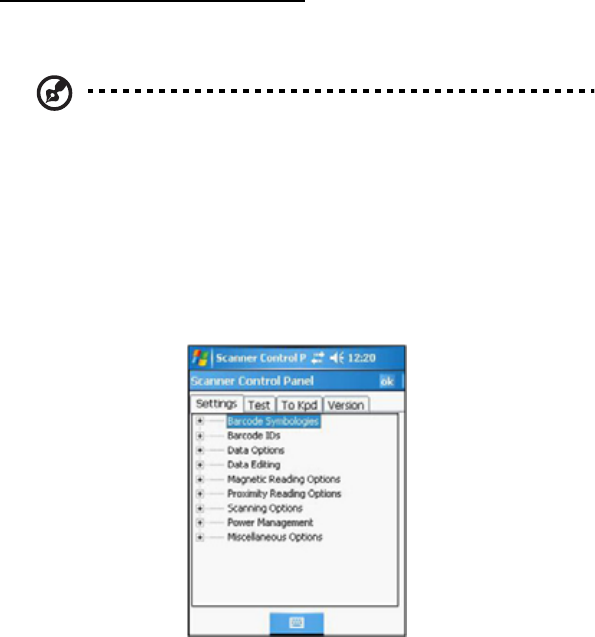
17
Using the Laser Scanner
PA500 has an integrated laser scanner which reads all major barcode
labels with excellent performance.
NOTE: The reading software must be enabled in order to operate the
scanner. This can be a user-loaded application or a pre-loaded utility
such as Scanner Settings.
PA500 has a built-in Scanner Settings utility that allows you to test the
device’s barcode scan function.
To launch Scanner Settings:
1 Tap Start > Settings > System tab.
2 On the System tab, tap Scanner Settings.
3 On the Settings tab, tap Barcode IDs.

Chapter 2 Hardware and Command Interface18
4Tap Test tab.
5 Activate the laser scanner by pressing either one of the trigger keys
located on the left and right side of the unit.
6 Aim the laser scanner at the selected barcode and press both trigger
keys to scan. The scanned barcode data appears on the screen.
7Tap OK.
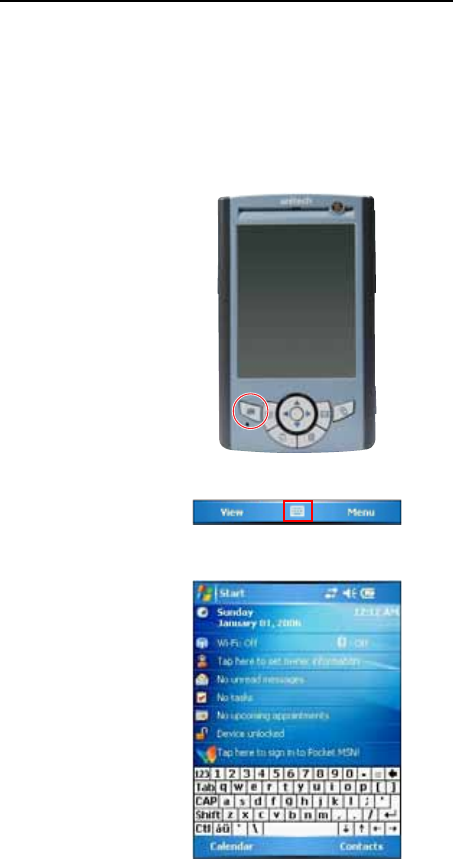
19
Using the Software Keyboard Button
The Windows CE software provides a touch screen keyboard for input of
other characters. The Windows based keyboard replicates the layout of a
standard PC keyboard.
To open the Windows CE keyboard:
Do either of the following:
• Press the Software keyboard button on the device’s front panel.
• Tap the keyboard icon on the command bar.
The Windows CE keyboard pops up.
To key-in characters:
Type information just like in a regular keyboard, by tapping the onscreen
keys.
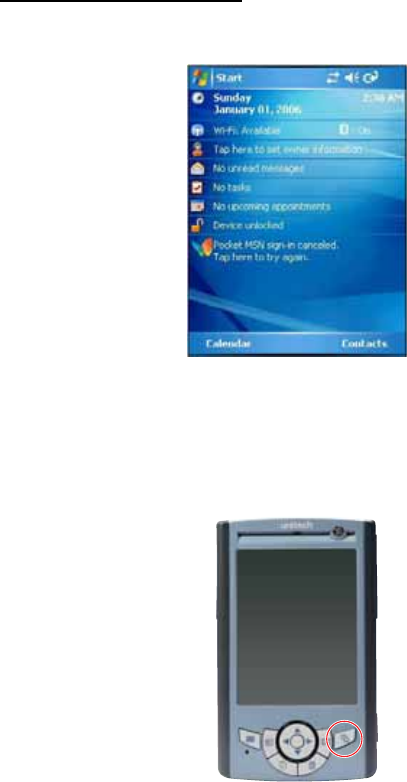
Chapter 2 Hardware and Command Interface20
Command Interface
Today Screen
When you turn on your device for the first time each day or after a preset
period of inactivity, you’ll see the Today screen. You can also display it by
doing either of the following:
• Tap Start > Today.
• Press the Today button on the device’s front panel.
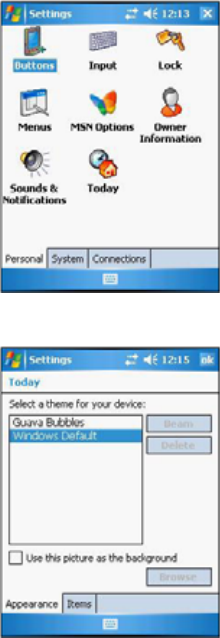
21
To define a preset period of inactivity after which the Today screen is
displayed:
1 Tap Start > Settings.
2 On the Personal tab, tap Today.
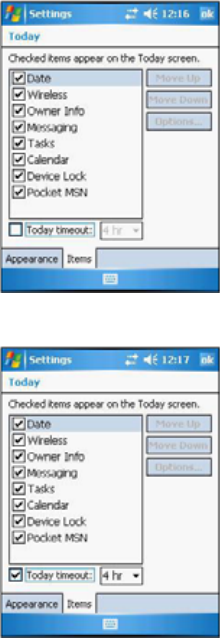
Chapter 2 Hardware and Command Interface22
3 On the Items tab, select the Today timeout check box.
4 Tap the pick list beside the check box to set the period of inactivity.
5 Tap OK.
Today screen provides an at-a-glance view of the important reminders
and details for the day.
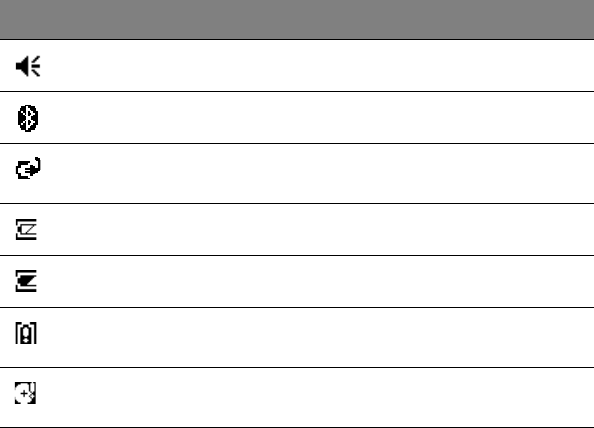
23
Status Icons
The table below describes some of the status icons you may see on your
device.
Status icon Description
Turns all sounds on and off.
Indicates Bluetooth wireless technology is on.
Indicates that the main battery is charging. The PA500 is either
plugged-in via the AC adapter or docking station.
Indicates the main battery is fully charged.
Indicates the main battery is low and needs to be charged.
Indicates the main battery is very low. Stop device operation and
charge the device immediately.
Indicates the backup battery is very low. Stop device operation
and charge the device immediately.

Chapter 2 Hardware and Command Interface24
Navigation Bar
The navigation bar is located at the top of the screen. It displays the active
program and current time, and allows you to switch to other programs and
close screens.
Command Bar
Use the command bar at the bottom of the screen to perform tasks in
programs. The command bar includes menu names, buttons, and the Input
Panel button.
• To create a new item in the current program, tap New.
• To view a notification or an image file received on your device, tap
View.
• To open the Windows CE keyboard.
• To see the name of a button, tap and hold the stylus on the button.
Drag the stylus off the button so that the command is not carried out.
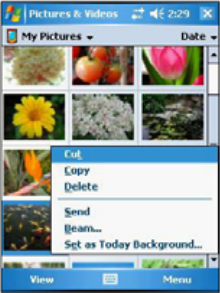
25
Pop-up Menus
With pop-up menus, you can quickly choose an action for an item. The
actions in the pop-up menus vary from program to program.
To access a pop-up menu:
1 Tap and hold the stylus on the item that you want to perform the action
on.
2 When the menu appears, lift the stylus, then do any of the following:
• Tap the action you want to perform.
• Tap anywhere outside the menu to close the menu without
performing an action

Chapter 2 Hardware and Command Interface26
Notifications
Your device reminds you in a variety of ways when you have something to
do or receive a message. For example, if you’ve set up an appointment in
Calendar, a task with a due date in Tasks, or an alarm in Clock, you’ll be
notified in any of the following ways:
• A message box appears on the screen.
• A sound, which you can specify, is played.
To choose reminder types and sounds for your device:
(1) Tap Start > Settings.
(2) On the Personal tab, tap Sounds & Notifications.
27
(3) On the Notifications tab, select the kind of events you want to be
notified of and the manner of notification you prefer. The options
you choose here are applied globally in your device.
(4) Tap OK.
Chapter 2 Hardware and Command Interface28

29
Chapter 3 Getting Connected
This chapter describes the procedures on how to connect the device to
your computer.
Establishing Device-PC Connection
Installing Microsoft ActiveSync
In order to exchange data between your computer and PA500, Microsoft
ActiveSync must be installed on your computer. The USB charging cable
that comes with your device enables you to connect the device to your
computer.
NOTE: If you have a previous version of the Microsoft ActiveSync
installed in your computer, uninstall it first before installing the latest
version of Microsoft ActiveSync.
Minimum system requirements
• Microsoft Windows 2000 SP 4; XP Media Center Edition; Server 2003
SP 1; Server 2003, XP Professional 64-Bit Edition (Itanium); XP SP 1;
XP SP 2; XP Tablet PC Edition
• Microsoft Outlook 2000 or later required for synchronization
• Microsoft Office 2000, Office XP or Office 2003
• Microsoft Internet Explorer 6.0 or later
To install Microsoft ActiveSync on your computer:
1 Close any open programs, including those that run at startup, and
disable any virus-scanning software.
2 Download the ActiveSync software from the Microsoft ActiveSync
Download page at http://www.microsoft.com/windowsmobile/
downloads/activesync42.mspx.
3 Install the ActiveSync setup software to your computer by clicking
appropriate language.
4 Select Run this program from its current location and click OK.
5 Follow the onscreen instructions to complete installation.
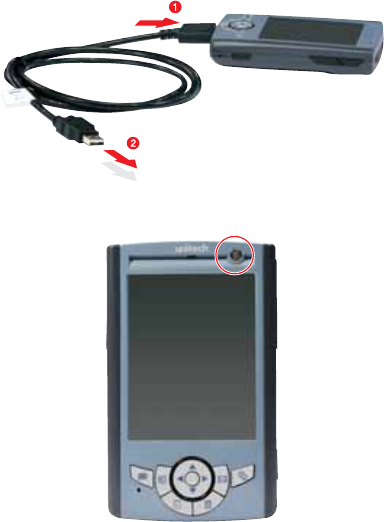
Chapter 3 Getting Connected30
After you have installed ActiveSync and restarted your computer, the
ActiveSync icon will appear on your computer’s system tray (on the
lower right-hand corner of the screen) and the ActiveSync wizard
appears.
For detailed information on how to use ActiveSync on your computer,
start ActiveSync; then click Help > Microsoft ActiveSync Help.
Connecting the Device to Your Computer
1 After ActiveSync has been installed, connect the USB charging cable
to your device. If necessary, connect an adapter.
2 Plug the other end of the USB charging cable into a USB port on your
computer.
3 Turn the device on.
4 After ActiveSync should start automatically and recognize your PA500
and configure the USB port. The New Partnership setup wizard will
automatically start.

31
NOTE: If ActiveSync doesn’t start automatically, click Start >
Programs > Microsoft ActiveSync > File > Connection Settings >
Connect > OK.
If a message appears indicating that it is unable to detect a
connection, click the Cancel button and manually configure the
communication settings.
5 Follow the onscreen instructions.
6 When the configuration process is complete, the ActiveSync window
appears.
7 Synchronization will be initialized and will take place if you’ve chosen
to synchronize periodically or upon connection.
NOTE: Your computer can create a partnership with multiple PA500.
Also, the PA500 can create a partnership with up to two computers.

Chapter 3 Getting Connected32
Synchronizing with Your Computer
Synchronization takes place according to the options you choose while
setting up ActiveSync on your computer. If you accept the default (On
Connect) synchronization option in the Microsoft ActiveSync Setup Wizard,
you’ll be able to simply connect your PA500 to your desktop computer and
sychronization will take place.
If you have not enabled the On Connect feature in ActiveSync, you can
start ActiveSync in either of the following ways:
• On your computer, double-click My Computer > Mobile Devices folder.
• Connect the USB cable between the computer and PA500.
• Execute “Repllog.exe” from the PA500 Windows directory
Connection Options
You can set remote synchronization with your computer using the following
connection options:
• USB connection
• Infrared connection
• Bluetooth connection
• WiFi connection
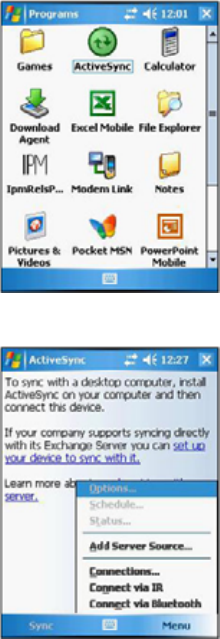
33
USB Connection
To synchronize with your computer using USB connection:
1 Open ActiveSync on your computer.
2 Connect your device to your computer using the USB charging cable.
See “Connecting the Device to Your Computer” on page 30.
3 Initiate connection by tapping Start > Programs > ActiveSync.
4 Tap Menu, then Connections.
5 Select Synchronize all PCs using this connection check box.
6 Select a baud rate or cable type connection.
7 Tap OK.
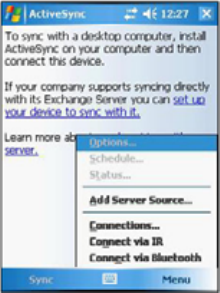
Chapter 3 Getting Connected34
Infrared Connection
The infrared (IR) port allows you to synchronize information with an
infrared-enabled computer. Simply align the infrared port of your device
with that on the computer. This method is ideal for quickly switching
between multiple devices since there are no cables or adapters to change.
1 Perform the steps below on your computer.
(1) Configure an infrared port on your computer following the
manufacturer’s instructions.
(2) Once your computer’s IR port is ready, open ActiveSync.
(3) Click File, then Connection Settings.
(4) Under the “In the Allow serial cable or infrared connection to this
COM port” list, select Infrared Port (IR).
(5) Click OK.
2 Perform the steps below on your device.
(1) Align the IR port of your device with that on your computer so that
they are unobstructed and within close range.
(2) Initiate connection by tapping Start > ActiveSync > Menu >
Connect via IR.
(3) Tap Sync.
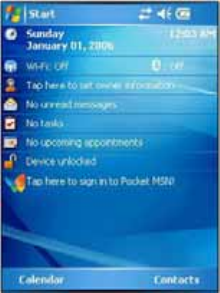
35
Bluetooth Connection
Your device is equipped with Bluetooth wireless technology that you can
use to synchronize information with a computer equipped with a Bluetooth
adapter or access point. Bluetooth wireless technology allows you to
communicate with the computer whenever it is within range.
1 Perform the steps below on your computer.
(1) On the Windows taskbar, click Start > Settings > Control Panel >
Bluetooth Devices.
(2) Click the Options tab, select the “Turn discovery on” and “Allow
Bluetooth devices to connect to this computer’s” options.
(3) On the COM port tab, click Add.
(4) Select “Incoming (device initiates the connection)”, then click OK.
Note the number of COM port that was added. The COM port
must not be higher than 20.
(5) In the ActiveSync window, click File menu, then Connection
Settings.
(6) Under the “In Allow serial cable or infrared connection to this COM
port” list, select the COM port with the number you noted in
step 3.
(7) Click OK.
2 Perform the steps below on your device.
(1) Enable Bluetooth on your device.
Using Today screen
(a) On the Today screen, tap WiFi.

Chapter 3 Getting Connected36
(b) Tap Bluetooth.
(c) Tap Done.
Using the Bluetooth program
(a) Tap Start > Settings.
(b) On the Connections tab, tap Bluetooth.

37
(c) On the Mode tab, select all the check boxes.
(d) Tap Devices tab and create a Bluetooth partnership. Refer to
page 47 for more information.
(2) Make sure that the device and computer are within close range.
(3) Initiate connection by tapping Start > ActiveSync > Menu >
Connect via Bluetooth.
(4) Tap Sync.

Chapter 3 Getting Connected38
WiFi Connection
With the device’s embedded WLAN module, you can send and receive
signals to a computer connected on the WiFi network then synchronize
files.
NOTE: Before doing these steps, you must do the following:
- Make sure your computer have TCP/IP installed.
- Make sure the network system and remote access server in your
workplace supports TCP/IP.
- Make sure you have remote access account. Ask your network
administrator for assistance on setting up a wireless connection.
- First establish ActiveSync partnership with the PA500 using serial,
USB or Bluetooth connection.
1 Perform the steps below on your computer.
(1) On the Windows taskbar, click Start > Settings > Control Panel >
Network Connections.
(2) Right-click WLAN card, then click Properties.
(3) Select Internet Protocol (TCP/IP), then click the Properties tab.
(4) IP settings will be assigned automatically if your network supports
this capability, then click Advanced.
(5) Click WINS tab.
(6) In the NetBIOS setting, select Enable NetBIOS over TCP/IP.
(7) Click OK.
(8) Connect your device to your computer using the USB charging
cable. See “Connecting the Device to Your Computer” on page 30.
(9) Perform a standard partnership with PA500.
(10) Click Next.
(11) Select Synchronize with this desktop computer, then click Next.
(12) Select the type of information you want to synchronize.
(13) Follow the onscreen instruction to complete setup.
(14) Open ActiveSync on your computer.
(15) Click File, then Connection Settings.
(16) Select Allow network (Ethernet) and Remote Access Service
(RAS) server connection with this desktop computer.
(17) Click OK.
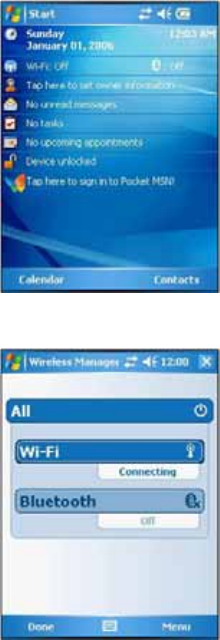
39
2 Perform the steps below on your device.
(1) Enable WiFi access on your device.
Using Today screen
(a) On the Today screen, tap WiFi.
(b) Tap Wi-Fi to enable.
(c) Tap Done.

Chapter 3 Getting Connected40
Using the Wireless Manager
(a) Tap Start > Settings.
(b) On the Connections tab, tap Wireless Manager.
(c) Tap Wi-Fi to enable.
(d) Tap Done.
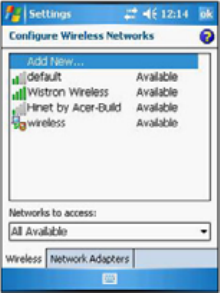
41
(2) If there are networks already detected, tap and hold network
name, then select Connect.
If none, tap Add New and follow all onscreen instructions.
(3) Under the Network to access drop-down menu, select Only
computer-to-computer.
(4) When finished, tap OK.
For more information on how to configure the wireless network
settings, tap Start > Help .

Chapter 3 Getting Connected42
Synchronizing Information
By default, ActiveSync does not enable automatic synchronization of all
types of information. To select the types of information you want
synchronized, on either your device or your computer, go to Menu, then
Options. This section gives you an overview of the types of Outlook
information you can synchronize.
Synchronizing Inbox
When you select E-mail for synchronization in ActiveSync, email messages
are synchronized as part of the general synchronization process. During
synchronization, the following events occur:
• Messages are copied from the Outlook Inbox folder on your computer,
or from a Microsoft Exchange server, to the Inbox folder (under the
ActiveSync account) on your device.
• By default, when synchronizing Inbox information with your computer,
you will receive only messages from the last three days and the first
0.5 KB of each new message. You can also choose to download file
attachments.
• The messages on your device and on your computer are linked. When
you delete a message on your device, it is also deleted from your
computer the next time you synchronize and vice versa.
• Messages in subfolders in other email folders in Outlook are
synchronized only if the folders have been selected for synchronization
in Inbox on your device.
NOTE: Text messages are not received in Inbox through
synchronization. Instead, they are sent to your device by way of your
mobile service provider.
Synchronizing Calendar
• Calendar items created on your device are copied to your computer
and/or on a Microsoft Exchange server during synchronization, and
vice versa. By default, Calendar items from the last two weeks will be
synchronized.
• Similarly, Calendar items that are deleted from your device are deleted
from your computer and/or server during synchronization, and vice
versa.
43
Synchronizing Contacts
• Contacts created on your device are copied to your computer or on a
Microsoft Exchange server during synchronization, and vice versa. By
default, all of your contacts will be synchronized.
• Similarly, contacts that are deleted from your device are deleted from
your computer and/or server during synchronization, and vice versa.
Synchronizing Tasks
• Task synchronization is, by default, automatically selected in
ActiveSync.
• Tasks can only be synchronized with your computer; they cannot be
synchronized with a server.
• Tasks created on your device are copied to your computer during
synchronization, and vice versa. By default, only incomplete tasks will
be synchronized.
• Similarly, tasks that are deleted from your device are deleted from your
computer during synchronization, and vice versa.

Chapter 3 Getting Connected44
Using ActiveSync to Exchange Files
You can use ActiveSync to exchange information from your device your
computer and vice versa. Changes you make to the information on one
location will not affect the information on the other one. If you want to
automatically update information on both your device and computer,
synchronize the information instead.
You can copy two types of information to your device: files and Pocket
Access Windows CE Store information.
The procedure below only applies to copying files. Refer to the ActiveSync
Help on your computer for instructions on how to copy Pocket Access
Windows CE Store information.
NOTE: Files created on your computer may need to be converted by
ActiveSync so that they can be viewed and edited on your device, and
vice versa.
To copy files:
1 Connect your device to your computer. You can connect your device to
your computer using the following connection options:
• USB connection
• Infrared connection
• Bluetooth connection
• WiFi connection
See “Synchronizing with Your Computer” on page 32 for more
information about the connection options.
2 On the ActiveSync window on your computer, click Explore .
Windows Explorer will open the Mobile Device window for your device.
3 Locate the file that you want to copy on your device or computer.
4 Do either one of the following:
• To copy the file to your device, right-click the file and click Copy.
Place the cursor in the desired folder for your device, right-click,
then click Paste.
• To copy the file to your computer, right-click the file and click Copy.
Place the cursor in the desired folder for your computer, right-
click, then click Paste.
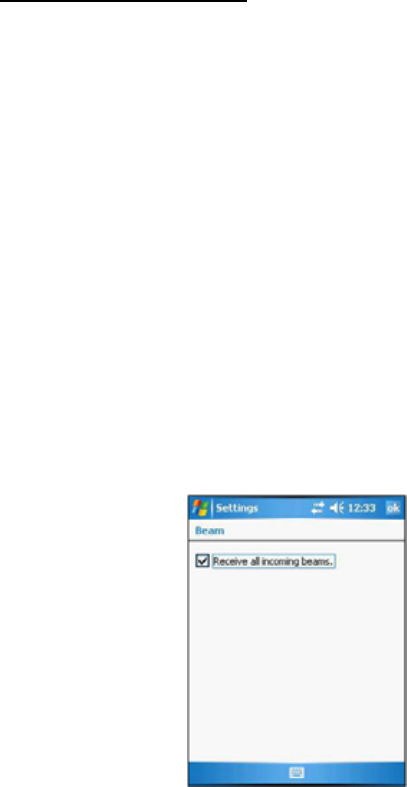
45
Sharing Information
You can use your PA500 to exchange information with other mobile devices
and connect to your computer, a network, or the Internet. You have the
following options:
• Infrared connection
• Bluetooth connection
• WiFi connection
• VPN connection
• Email server connection
Infrared connection
Using the infrared (IR) port on your device to beam information, such as
contacts and appointments, from another IR-enabled device.
Setting up an IR connection
1 Activate the device’s IR port.
(1) Tap Start > Settings.
(2) On the Connections tab, tap Beam.
(3) Tap the Receive all incoming beams check box.
(4) Tap OK.
Sending and receiving information via IR
To send information via IR:
1 Switch to the program where you created the item you want to send
and locate the item in the list.
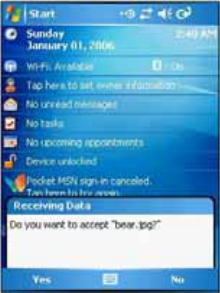
Chapter 3 Getting Connected46
2 Align the IR port of your device with that of the IR-enabled device so
that they are unobstructed and within a close range.
3 Do any one of the following:
• Tap and hold the item, then tap Beam Task on the pop-up menu.
• Using File Explorer, tap and hold the item (but not folder), then
select Beam File on the pop-up menu.
• Using Pictures & Videos, tap and hold a thumbnail to display a
pop-up menu of available actions, then tap Beam.
4 Select the IR device, then tap the Tap to send link.
To receive information via IR:
1 Align the IR port of your device with that of the IR-enabled device so
that they are unobstructed and within close range.
2 Have the owner of the other device send the information to you. Your
device will automatically receive it.
3 On the Receiving Data callout, tap Yes.
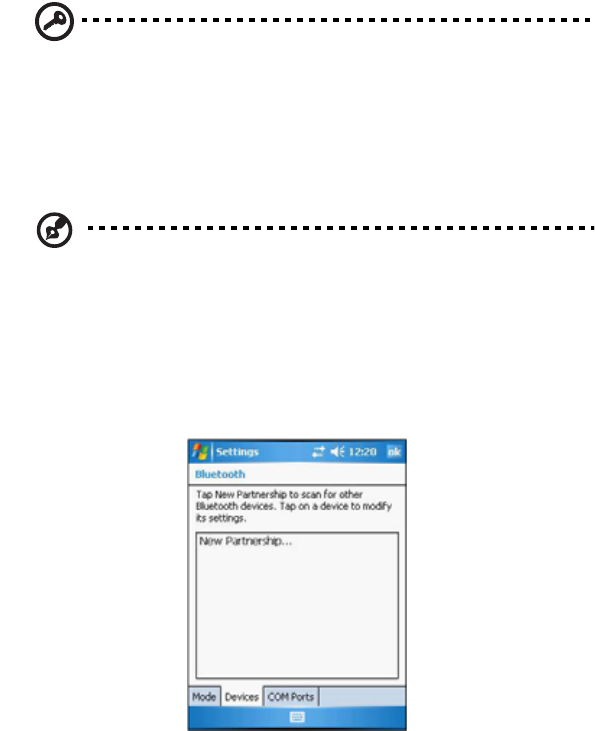
47
Bluetooth connection
Your device allows you to connect to a Bluetooth-enabled device, such as a
handheld, headset, or computer. Once connected you can do the following:
• Beam files and information in Calendar, Contacts, Notes, Tasks, Excel
Mobile, Word Mobile, PowerPoint Mobile, and Pictures & Videos
programs, to other Bluetooth-enabled device.
• Wirelessly listen to audio files or locate and use services on a
Bluetooth-enabled device.
• Locate and use any services available on the device.
IMPORTANT: Ensure that the two devices have Bluetooth turned on,
discoverable, and within close range.
Setting up a Bluetooth connection
1 Activate the device’s Bluetooth feature.
To activate Bluetooth connection, refer to “Enable Bluetooth on your
device using Today screen” on page 35 for more information.
NOTE: Deactivate the Bluetooth feature when you do not plan to use it
for an extended time.
2 Create a partnership between your device and another device.
(1) Tap Start > Settings.
(2) On the Connections tab, tap Bluetooth.
(3) On the Devices tab, tap New Partnership.

Chapter 3 Getting Connected48
Your device will search for other devices with Bluetooth
capabilities and displays them in the device list.
(4) Tap the name of the device in the list, then tap Next.
(5) If you want to use a passkey, enter the alphanumeric passkey,
then tap Next. Or, you can leave the passkey blank, then tap Next.
The passkey is recommended for enhanced security. Your
passkey must be between 1 to 16 alphanumeric characters.
(6) In the Display Name box, enter a new name for the device.
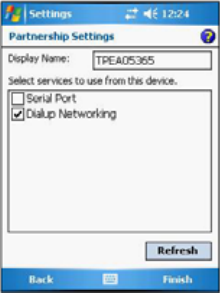
49
(7) In the “Select services to use from this device” list, select a
service.
(8) Tap Finish.
Sending and receiving information via Bluetooth
To send information via Bluetooth:
1 Switch to the program where you created the item you want to send
and locate the item in the list.
2 Do any one of the following:
• Tap and hold the item, and then tap Beam Task on the pop-up
menu.
• Using Pictures & Videos, tap and hold a thumbnail to display a
pop-up menu of available actions, then tap Beam.
• Using File Explorer, tap and hold an item (but not folders), select
Beam File on the pop-up menu.
3 Select the Bluetooth device, then tap the Tap to send link.
To receive information via Bluetooth:
1 Turn on the Bluetooth function.
2 Have the owner of the other device send the information to you. Your
device will automatically receive it.
3 On the Bluetooth callout, tap Yes.
A Bluetooth connection with your device is indicated by at the top of
the screen.
For detailed information on how to use Bluetooth, tap Start > Help.

Chapter 3 Getting Connected50
WiFi connection
Windows Mobile can support TCP/IP protocol, so the user can easily
connect to the Internet by modem or high-frequency wireless LAN
technology. WiFi networks look and operate similarly to Ethernet networks.
The only difference is that a radio transmission replaces the hard-wire
connection between the various nodes. This means all of your existing
applications that currently operate over Ethernet will also function utilizing
WLAN without any special wireless network software.
With PA500 integrated WiFi, you can scan for existing wireless network
access point or hot spot. Wireless network access point or hot spot can be
found in homes and offices or public areas such as inside the airport,
restaurant, coffee shops, hotels, subway stations, or campus. Using WiFi
networking, you can connect to a computer, access the Internet, send and
receive email and files.
A wireless network can be added either when the network is detected or by
manually entering settings information. WiFi access in some areas may
require a separate purchase of a service contract with a wireless service
provider. You can check with a WiFi service provider for detailed
information.
NOTE: Before doing these steps, you must do the following:
- Make sure your computer have TCP/IP installed.
- Make sure the network system and remote access server in your
workplace supports TCP/IP.
- Make sure you have remote access account. Ask your network
administrator for assistance on setting up a wireless connection.
- First establish ActiveSync partnership with the PA500 using serial,
USB or Bluetooth connection.
Setting up a wireless network connection
NOTE: Before doing these steps, determine if authentication
information is needed.
1 Enable wireless connection. Refer to “Enable WiFi access on your
device.” on page 39 for more information.
2 Tap Start > Settings.
3 On the Connections tab, tap Network Cards.
4 Tap the Wireless tab.
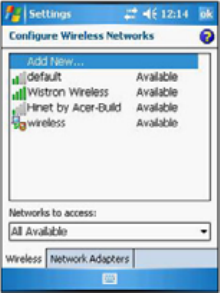
51
If there are networks already detected, tap and hold network name,
then select Connect.
If none, tap Add New and follow all onscreen instructions.
5 Under the Network to access drop-down menu, select from the
following network connection options:
• All available
• Only access points
• Only computer-to-computer
6 When finished, tap OK.
To configure the wireless network connection settings, tap Start>
Settings > Connections tab > Network Cards. For more information on
how to configure the wireless network settings, tap Start > Help .
VPN connection
If you have access to a network at work, you can send email messages,
view Intranet pages, synchronize your device, and possibly access the
Internet. You can connect to a network by creating a modem connection via
a RAS (Remote Access Services) account or use a network card to
connect directly to an Ethernet network and access Internet, Intranet or
download emails. Before you can create these connections, your network
administrator will need to set up a RAS account for you. Your network
administrator may also give you the VPN (Virtual Private Network) settings.
Setting up a VPN connection
1 Ask your network administrator for the following information:
•User name
Chapter 3 Getting Connected52
• Password
• Domain name
• TCP/IP settings
• Host name or IP address of the VPN server
2 Tap Start > Settings.
3 On the Connections tab, tap Connections.
4 On the Tasks tab, tap Add a new VPN server connection.
5 Follow all onscreen instruction in the New Connection wizard. For
more information, tap Start > Help.
Email server connection
You can set up a connection to an email server so that you can send and
receive email messages by using a modem or network connection and
Inbox on your device. You can use multiple email accounts to receive your
messages. For each email account you intend to use, first set up and name
the email service. If you use the same service to connect to different
mailboxes, set up and name each mailbox connection.
There are two types of email account that can be managed using your
device.
• Microsoft Outlook
Using Microsoft Outlook, your Inbox is updated each time you sync
with your computer or corporate email server.
• POP3/IMAP4
This includes email service from providers. These email accounts can
be managed remotely using a wireless connection.
For more information, tap Start > Help.

53
Connecting to the Internet
Your PA500 allows you to connect to your ISP (Internet Service Provider)
and use the connection to do the following:
• Send and receive email messages
• View the Internet and Intranet
• Access Web pages
• Listen to streaming media
To connect to the Internet:
1 Ask your ISP for the following information:
• Dial-up access telephone number or access point
• User name and password
2 Tap Start > Settings.
3 On the Connections tab, do one of the following:
• Tap Connections, then in My ISP, tap the Add a new modem
connection link.
• Tap Network Cards and set up a network card or wireless network
connection.
4 Follow all onscreen instruction in the New Connection wizard.
For more information, tap Start > Help.
Chapter 3 Getting Connected54
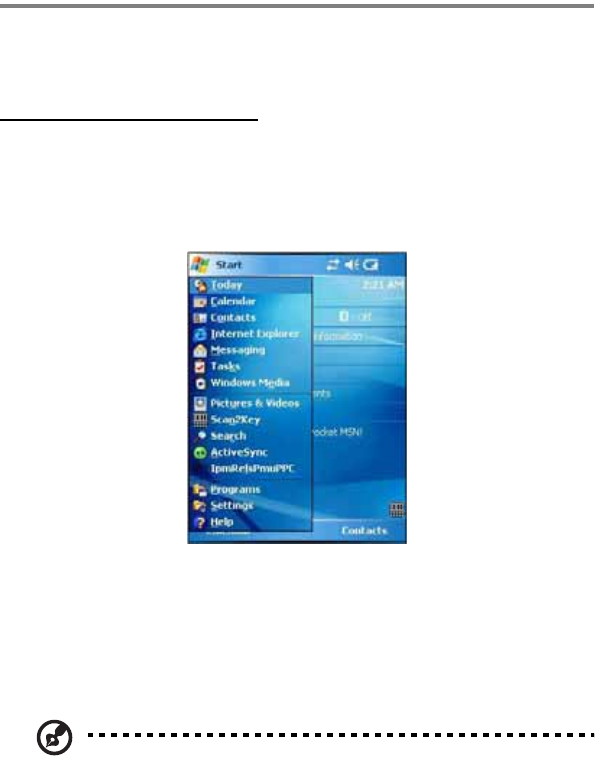
55
Chapter 4 Managing Programs
This chapter describes the procedures for launching programs. It also
shows how to use the Scan2Key and Scanner Setting accessory programs.
Accessing Programs
Opening a Program
You can open programs in any one of the following ways:
• Tap a program name from the Start menu.
• You can select which programs are displayed on the Start menu. For
instructions, see Adding a program to the Start menu on page 71.
• Tap Start, then Programs to see more programs.
Switching Between Programs
• Select another program from the Start menu.
NOTE: To get detailed information on using any of the applications on
your device, tap Start > Help.
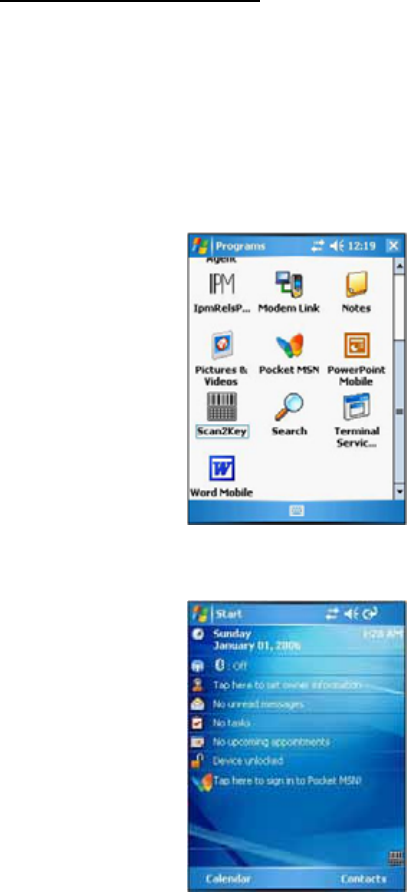
Chapter 4 Managing Programs56
Accessory Programs
Scan2Key
The Scan2Key application can route input from a scanner port to keypad
buffer, so that all input from scanner will be treated as they are just input
from touch screen keyboard. With this router, scanned data can be directly
input into scanner port aware application, like MS Pocket Word.
To launch Scan2Key:
1 Tap Start > Programs.
2 Tap Scan2Key. Scan2Key will appear on lower right corner of the
Today screen.

57
To exit Scan2Key:
1 Tap and hold the Scan2Key icon then tap Exit on the pop-up menu.
The Quit Scan2Key dialog box appears.
2Tap Yes.
Scanner Settings
When it is necessary for the user to change the default barcode symbology
for a different application, the Scanner Control Panel provides the ability to
change default symbology. The Scanner Control Panel also lets you place
delimiter characters behind scanned data and save the settings.
To view the default barcode symbologies:
1 Tap Start > Settings.
2 On the System tab, tap Scanner Settings.
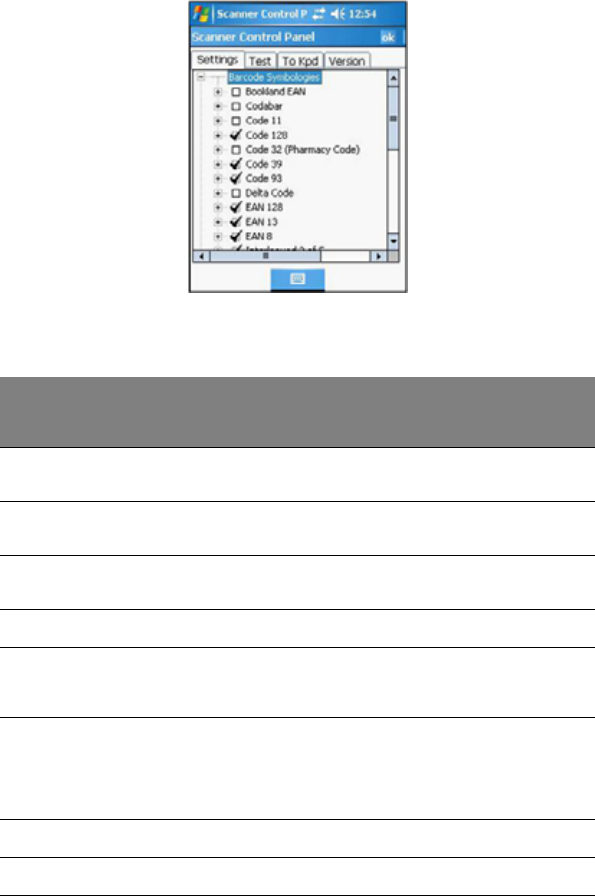
Chapter 4 Managing Programs58
3 On the Settings tab, tap the plus sign in front of Barcode Symbologies
to expand and display the list of barcode symbologies.
Below table lists the standard protocol for a particular type of barcode
symbology.
Barcode
Symbology Enable/
Disable
Check
Char/ Digit
Verification
Transmit
check
char/digit
Transmit
start &
stop bits Other
Bookland
EAN Yes
CodaBar Yes Yes Yes Yes CLSI format
3 to 48, data length
Code 11 Yes Yes 2 check digits
1 to 48, data length
Code 128 Yes 1 to 64, data length
Code 32
(Pharmacy
Code)
Yes Transmit leading digit
Transmit tailing digit
Code 39 Yes Yes Yes Yes Full ASCII
Function Code
0 to 48, data length
Double labels decoding
Double labels separator
Code 93 Yes 1 to 48, data length
Delta Code Yes Yes Yes

59
EAN 128 Yes Transmit code ID
Fields separator
EAN 13 Yes Yes Transmit leading char/
digit
EAN 8 Yes Yes Transmit leading digit
Interleaved
2 of 5 Yes Yes Yes Not Suppress start or
stop digit
Fixed length
10 to 64, data length
Label Code
IV & V Ye s Yes
MSI/Plessy Yes Yes Check digital double
module 10
1 to 16, data length
Standard 2 of
5/Toshiba
(China Postal
Code) Group
Yes Yes Yes Fixed length
4 to 48, data length
Telpen Yes Standard character set
UPC A Yes Yes Transmit leading char/
digit
UPC E Yes Yes Transmit leading char/
digit
Zero Expansion
NSC
UPC/EAN
group Supplement 2
Supplement 5
Insert space before
supplement
Must have supplement
Add-on code try level
Barcode
Symbology Enable/
Disable
Check
Char/ Digit
Verification
Transmit
check
char/digit
Transmit
start &
stop bits Other
Chapter 4 Managing Programs60
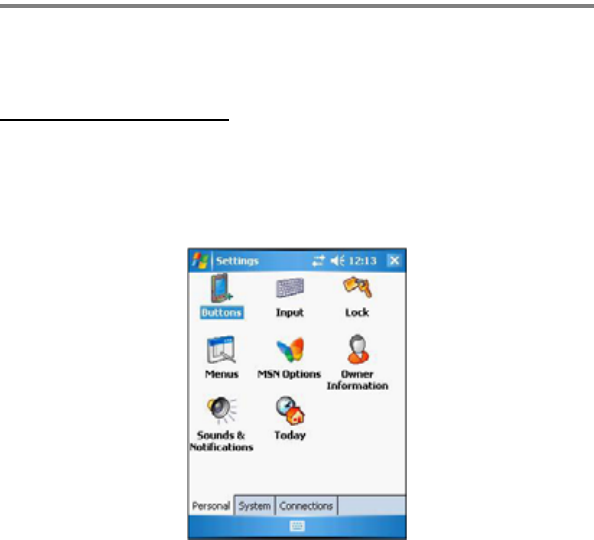
61
Chapter 5 Customizing PA500
This chapter describes the procedures on how to adjust the settings of your
device.
Adjusting Settings
You can adjust the settings of your device to suit the way you work.
Adjusting certain settings, such as backlight, auto power off timer, system
volume, and processor speed.
To access Settings, tap Start > Settings.
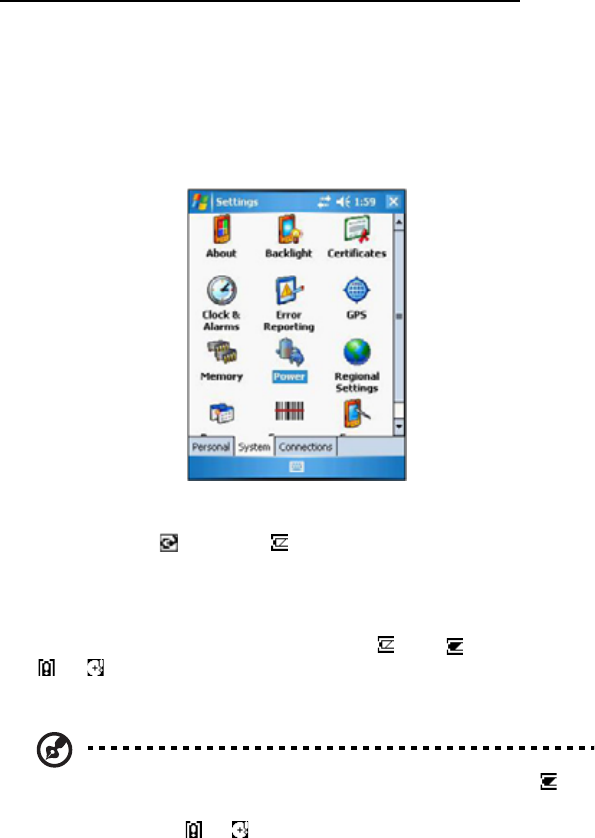
Chapter 5 Customizing PA50062
Checking Main and Backup Battery Status
View power level for both the main and backup battery. To minimize power
consumption, you can define settings for the auto-off function and the
processor’s operation speed.
To check the main and backup battery status:
1 Tap Start > Settings.
2 On the System tab, tap Power.
3 Do either of the following:
• If the Plug or Battery icon appears on your device, double-
tap the icon to bring the Power settings screen.
• Tap Start > Settings > System tab > Power.
4 The battery tab will show the status of the main and backup batteries.
There are four kinds of status icons, Good , Low , and Very Low
or , that may appear on the top of the Today screen to indicate
main battery or backup battery status. For more information on the
battery status icons, see page 23.
NOTE: It is necessary to charge the main battery when the Low is
displayed. To prevent data loss, replace or recharge the device when
the Very Low or status icons are displayed. If both icons are
still displayed after charging, pls. contact Unitech Technical Support.
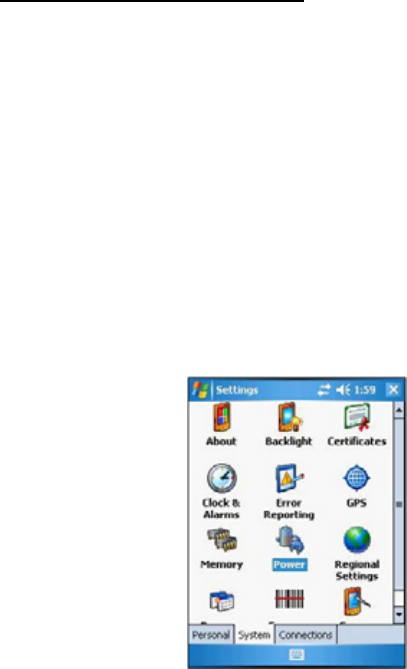
63
How to Save Battery Life
You can save your device’s battery life by doing either of the following:
• Change the automatic power settings
• Minimize use of backlight
Changing the Automatic Power Settings
The PA500 will enter idle mode when there is no task, or all tasks are
waiting for input. In default setting, the PA500 will automatically turn itself
off if it remains idle for 3 minutes and when there is no external charging
power applied. Pressing the power button will return the PA500 to the same
point at the time of automatic shutdown.
To change the automatic power settings:
1 Tap Start > Settings.
2 On the System tab, tap Power.
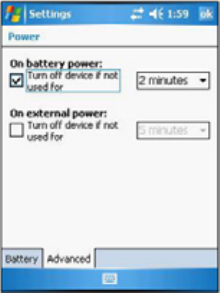
Chapter 5 Customizing PA50064
3 Tap the Advanced tab, then tap the “On battery power turn off device if
not used for” check box and change the amount of time before the unit
turns off the backlight while running in battery power mode.
This function can also be activated when the PA500 is plugged into the
power adapter or placed in its docking station. On the Advanced tab,
tap the “On external power turn off device if not used for” check box
and change the amout of time before the unit turns off the backlight
while running in external power mode.
Adjusting Backlight Setting
The power consumption of the LCD backlight is high, turn off the backlight
function if it is not necessary.
If a backlight is required, set “automatically turn off the back-light” function.
To change the backlight settings:
1 Tap Start > Settings.

65
2 On the System tab, tap Backlight.
3 On the Battery Power tab, do either of the following:
• Tap the “Turn off the backlight if device is not used for” check box
and change the amount of time before the unit turns off the
backlight while running in battery power mode.
• Tap “Turn on backlight when button is pressed or the screen is
tapped” check box.
4 On the External Power tab, do either of the following:
• Tap the “Turn off backlight if device is not used” check box and
change the amount of time before the unit turns off the backlight
while running in external power mode.
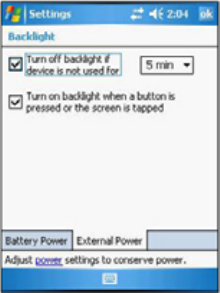
Chapter 5 Customizing PA50066
• Tap the “Turn on backlight when a button is pressed or the screen
is tapped” check box.

67
Resetting the Device
There are three kinds of reset that you can perform on your device when
the device’s operating system stops responding or the system becomes
corrupted. Depending on the situation, a warm boot, clean boot, or cold
boot can be performed.
Warm Boot
You may have to perform a warm boot if the device freezes (i.e., device no
longer responds to the buttons on the screen).
To perform a warm boot:
A warm boot or soft reset allows your device to get a fresh start, similar to
rebooting a computer. This will restart your device and adjust memory
allocation. All records and entries are retained after a warm boot. Unsaved
data in open programs may in some cases be lost.
1 Remove the stylus from its holder.
2 Lightly press the tip of the stylus to the reset button located on the rear
of the device.

Chapter 5 Customizing PA50068
Clean Boot
A clean boot allows your device to load the main operating system and
perform diagnostic tests to determine the boot process problems.
To perform a clean boot:
1 Hold down the right and left scanner trigger buttons.
2 While holding down the scanner trigger buttons, gently press the tip of
the stylus to the reset button located on the rear of the device.
Cold Boot
A cold boot will cut off power to your device. This will erase all records and
entries, delete all programs you have added, and restore the device default
factory settings. Never perform a cold boot unless a warm or clean boot
does not correct your problem. When you perform your next ActiveSync
operation, you can restore any data that you previously synchronized to
your computer or you can restore data that you backed up to a storage
card.
NOTE: When you perform a cold boot, the date and time settings are
not retained. Formats, preferences, and other settings are restored to
their default factory settings.
To perform a cold boot:
1 Hold down the power button.
2 While holding down the power button, gently press the tip of the stylus
to the reset button located on the rear of the device.

69
Viewing Flash ROM Files
Flash ROM (read-only memory) is a rewritable storage for programs and
data files. The benefit of this feature is that files and programs saved in
Flash ROM are unaffected by the PA500 power status.
To access the Flash Memory files:
1 Connect the device to your computer. See page 30.
2 On your computer, click My Computer > Mobile Device > Flash
Storage.
To transfer files to Device’s Flash Memory:
1 Connect the device to your computer. See page 30.
2 On your computer, click My Computer > Mobile Device >Flash
Storage.
3 Select the file that you want to save.
4 Click File > Save To and select Flash Storage.

Chapter 5 Customizing PA50070
Adding Programs
Adding Programs to Your Device
Programs bundled with your device at the factory are stored in Flash ROM.
You cannot remove these programs, and you’ll never accidentally lose
Flash ROM contents. Software programs and data files added to your
PA500 after factory installation can be stored in RAM (random access
memory).
To add programs using ActiveSync:
Before installing a program on your device, you must first install the
appropriate software to your device on your computer.
1 Determine your device and processor type so that you know which
version of the software to install.
(1) Tap Start > Settings.
(2) On the System tab, tap About.
(3) On the Version tab, make anote of the processor information.
2 Download the program to your computer (or insert the CD or disk that
contains the program into your computer).
You may see a single *.xip, *.exe or *.zip file, a Setup.exe file, or
several versions of files for different device types and processors. Be
sure to select the program designed for Pocket PC and your device’s
processor type.
NOTE: Read any installation instructions. Read Me files or
documentation that come with the program. Many programs provide
special installation instructions.
3 Connect your device to your computer.
4 Double-click the *.exe file.
• If the file is an installer, the installation wizard will begin. Follow
the directions on the screen. Once the software has been installed
on your computer, the installer will automatically transfer the
software to your device.

71
• If the file is not an installer, you will see an error message stating
the program is valid but is designed for a different type of
computer. You will need to move this file to your device. If you
cannot find any installation instructions for the program in the
Read Me file or documentation, use ActiveSync Explore button to
copy the program file to the Program Files folder on your device.
For more information on copying files using ActiveSync, see page
44.
5 Once installation is complete, tap Start > Programs, then the program
icon to launch it.
If you are installing a *.cab file on your device, open ActiveSync on
your desktop, then click the Explore button. The application will install
on your device.
To add a program from the Internet:
1 Determine your device and processor type so that you know which
version of the software to install. Refer to previous section for
instructions.
2 Download the program to your device straight from the Internet using
Internet Explorer Mobile.
NOTE: Read any installation instructions. Read Me files or
documentation that come with the program. Many programs provide
special installation instructions.
3 Tap the file, such as *.xip or *.exe file. The installation wizard will begin.
4 Follow the onscreen instructions.
Adding a Program to the Start Menu
You can choose what program icons should appear on the menu based on
which ones you use most often.
To add a program to the Start menu program using Settings:
1 Tap Start > Settings.

Chapter 5 Customizing PA50072
2 On the Personal tab, tap Menus.
3 Select the check box for the programs you wish to add.
If you do not see the program you want, you can either use File
Explorer on your device to move the program to the Start Menu folder,
or use ActiveSync on your computer to create a shortcut to the
program and place the shortcut in the Start Menu folder.
4 Tap OK.
To add a program to the Start menu program using File Explorer on your
device:
1 Tap Start > Programs > File Explorer.
2 Tap the My Device icon (tap the folder list, labeled My Documents by
default, and then My Device to see a list of all folders on your device).
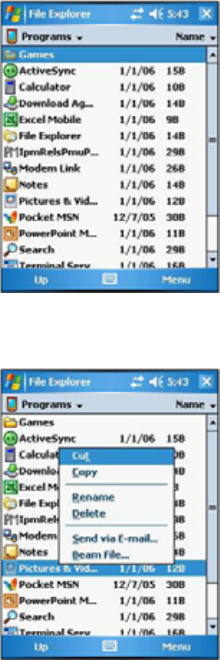
73
3 Open the path: Windows | Start Menu | Programs.
4 Tap and hold the program you want to add to the menu, then tap Cut
on the pop-up menu.
5 Open the path: Windows | Start Menu.
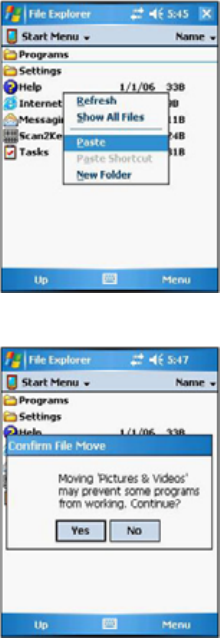
Chapter 5 Customizing PA50074
6 Tap and hold a blank area of the screen, then tap Paste on the pop-up
menu.
7 A Confirm File Move dialog box appears, tap Yes.
The program will now appear on the Start menu.
To add a Start menu program using ActiveSync on your computer:
1 In the ActiveSync on your computer, click Explore to explore your
device’s files and locate the program.
2 Right-click the program, and then click Create Shortcut.
3 Open the path: Mobile Devices | Windows | Start Menu.
4 Move the shortcut to the Start Menu folder. The shortcut now appears
on the Start menu.
For more information on using ActiveSync, see ActiveSync Help on
75
your computer.
Removing Programs
1 Tap Start > Settings.
2 On the System tab, tap Remove Programs.
3 Tap the program you wish to remove.
4 Tap the Remove button.
If the program does not appear in the list of installed programs, use File
Explorer on your device to locate the program:
1 Tap and hold the program.
2 Tap Delete on the pop-up menu.
Chapter 5 Customizing PA50076

77
Chapter 6 Regulatory and Safety Notices
This chapter lists the specifications and regulatory and safety notices of
PA500.
System Specifications
CPU/Memory
CPU Intel PXA270 processor with speed of up to 520 MHz
Flash ROM 64 MB Built-in (Flash Memory Manager included)
SDRAM 64 MB
Input/Output
Input Devices • Touch screen
•Stylus
• Control buttons
• Full alphanumeric software keyboard
• Mag stripe reader
• Barcode scanner
Control and Quick
launch hot keys
• Navigation key
• Software keyboard button
• Email button
• Today button
• Calendar button
• Tasks button
• Notes button
Audio • Built-in speaker
• 3.5 mm stereo earphone jack
• Microphone
Display • 3.5” QVGA LCD touch-sensitive screen and
Electroluminescent backlight
• 320 x 240 resolution
LED Indicator Dual colors (green/red) for barcode read indication
Chapter 6 Regulatory and Safety Notices78
Input/Output
Scan Engine • Light Source: Visible Laser Diode(VLD) 650 nm.
• Min. print contrast: 25% absolute dark/light
reflectance at 650 nm
• Power Consumption: 65 mA typical@5 V
Connectivity • USB port
• SDIO/MMC slot
Wireless connectivity • Bluetooth
• Version: 1.1 and 1.2 with class 2 specification
• Peak output power: 2 ±2 dBm
• Frequency band: 2400-2483.5 MHz
• Operating channels: 79 Channels
• Modulation Type: GFSK
• WLAN (802.11b)
• 802.11b low power (3.96 mW deep sleep mode)
• Peak output power: 18 ±2 dBm
• Frequency band: 2400-2483.5 MHz
• Operating channels: 11 Channels
• Modulation Type:
- CCK (1Mbps)
- DBPSK (2Mbps)
- DQPSK (5.5/11Mbps)
• WLAN (802.11g)
• 802.11g low power (3.96 mW deep sleep mode)
• Peak output power: 15 ±2 dBm
• Frequency band: 2400-2483.5 MHz
• Operating channels: 11 Channels
• Modulation Type: OFDM (6~54Mbps)
• Serial infrared port
79
Power
Main battery Standard battery: 3.7 V, 2200 mAh
Battery life 6 hours
Battery charge • 3.5 hours with external AC adapter
• 3.5 hours with docking station
Backup battery One hour data retaining time when main battery is
removed
Power management • Provide all voltage outputs required in this terminal
• Retain memory content more than 72 hours after
automatic low battery shutdown
• Provide 6 hours operating time with a standard
battery. The activities in operating period are:
(1) Scan one barcode.
(2) Send this barcode data to the host via wireless
LAN.
(3) Repeat items 1 and 2 every 5 seconds.
• Provide 3-level battery status to show main battery
capacity
• Provide 3-level battery status to show back-up
battery capacity
• 3.5 hours charging time
• 16 hours backup battery charging time
Chapter 6 Regulatory and Safety Notices80
Barcode/Symbology
Barcode Scanner Symbol SE950
Symbology • Bookland EAN
• Codabar
• Code 11
• Code 128
• Code 32 (Pharmacy
Code)
• Code 39
• Code 93
• Delta Code
• EAN 128
•EAN 13
•EAN 8
• Interleaved 2 of 5
• Label Code IV & V
• MSI/Plessy
• Standard 2 of 5/
Toshiba (China Postal
Code) group
• Telpen
•UPC A
•UPC E
• UPC/EAN group
OS and Software Programming Tools
OS Microsoft Windows Mobile 5.0
Language Support • International English
• Japanese
• Simplified Chinese
• Traditional Chinese
Mechanical and Environmental
Dimensions • Length: 126 mm
• Width: 76 mm
• Depth: 23 mm
Weight 220 g
Temperature • Operating: 0° to 50°C
• Non-operating: -20° to 60°C
Humidity Operating/Non-operating: 5% to 95% RH
Vibration Operating/Non-operating: 2g, 10 - 500 Hz
Shock • Operating: 10 g
• Non-operating: 15 g
Drop 120 cm, without major damage

81
Regulatory Compliance Statements
FCC Statement
This is a FCC Part 15 Class B product. In a domestic environment this
product may cause radio interference, in which case the user may be
required to take adequate measures.
Canadian Compliance Statement
This Class B Digital apparatus meets all requirements of the Canadian
Interferance-Causing Equipment Regulations.
Cet appareil numerique de la classe B respecte les exigences du
Reglement sur le material broilleur du Canada.
The device is certified to the requirements of RSS-139-1 for 2.4 GHz
spread spectrum devices.
European Conformity Statement
Declaration of Conformity with Regard to the R&TTE 1999/5/EC and EMC
89/336/ EEC directives.
Laser Information
The Unitech PA500 series is certified in the U.S. to conform to the
requirements of DHHS/CDRH 21CFR Subchapter J and to the
requirements of IEC 825-1. Class II and Class 2 products are considered to
be hazardous. The PA500 series contains internally a Visible Laser Diode
(VLD) whose emissions do not exceed the maximum limits as set forth in
the above regulations. The scanner is designed so that there is no human
access to harmful laser light during normal operation, user maintenance or
during prescribed serviceoperations.
The laser safety warning label required by the DHHS/IEC for the PA500
series’s optional laser scanner module is located on the memory
compartment cover, on the back of the unit.
CAUTION - Use of controls or adjustments or performance of procedures
other than those specified herein may result in hazardous laser light. Use of
optical instruments with the scanner will increase eye hazard. Optical
instruments include binolulars, microscopes, and magnifying glasses. This
does not include eye glasses worn by the user.
Chapter 6 Regulatory and Safety Notices82
83
Index
A
accessories 2
accessory program
Scan2Key 56
Scanner Settings 57
adding programs
from Internet 71
to Start menu 71
using ActiveSync 70
B
battery pack
installing 9
Bluetooth 47
activate 47
create partnership 47
receive items 49
send items 49
C
Canadian Compliance Statement 81
charge 9
charge device
docking station 10
USB charging cable 10
command
pop-up menus 24
command interface
bar 24
navigation bar 24
pop-up menus 25
status icons 23
today screen 20
connectivity features
Bluetooth 47, 49
connect to email server 52
connect to network 51
infrared 45, 46
VPN 51
WiFi 50
customize features
remove program 75
customizing PA500 61
add programs 70
adjusting settings 61
check backup battery status 62
check main battery status 62
reset device 67
save battery life 63
view Flash ROM 69
D
device
charge 9
E
European Conformity Statement 81
exchange files
using ActiveSync 44
F
FCC statement 81
features 3
audio 3
barcode scanner 3
battery life 3
display 3
powerful system 3
user-friendly interface 3
wireless connectivity 3
first steps 9
G
getting connected 29
device-PC connection 29
H
hardware
laser scanner 15
SDIO/MMC slot 15
stylus 15
I
information
sharing 45
synchronizing 42
infrared
activate 45
receive items 46
send items 45
installing
battery pack 9
Microsoft ActiveSync 29
interface
command 15
hardware 15
Index84
Internet 53
connect 53
introduction 1
L
laser information 81
laser scanner 17
LED status 12
M
manage programs 55
accessing 55
accessory programs 56
opening a program 55
switching between programs 55
Microsoft ActiveSync
installing 29
system requirements 29
N
notice ii
battery charge ii
storage and safety ii
O
options
Bluetooth 32
infrared 32
USB 32
WiFi 32
R
regulatory compliance statements 81
Canadian Compliance 81
European Conformity 81
FCC 81
laser information 81
regulatory notice 77
remove program 75
reset device
clean boot 68
cold boot 68
warm boot 67
S
safety notice 77
save battery life
adjust backlight setting 64
change power settings 63
Scan2Key 56
Scanner Settings 57
SDIO/MMC slot 16
sharing information
Bluetooth 47
infrared 45
options 45
VPN 51
WiFi 50
software keyboard 19
specifications
barcode symbology 80
CPU 77
input/output 77
mechanical and environmental
80
memory 77
OS and tools 80
power 79
Start menu
adding program 71
start up 12
stylus 15
synchronization 32
options 32
synchronizing
Calendar 42
Contacts 43
Inbox 42
information 42
Tasks 43
T
tour 4
bottom view 8
front view 4
left view 7
rear view 6
right view 7
top view 8
U
using
laser scanner 17
SDIO/MMC slot 16
software keyboard 19
stylus 15
Index86